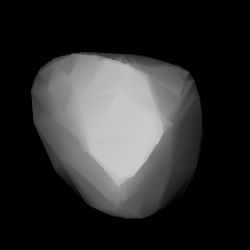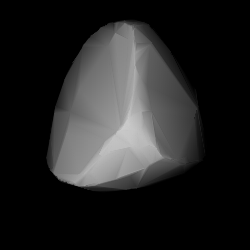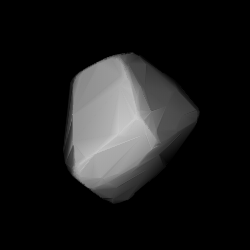
1039 Sonneberga, provisional designation 1924 TL, is a dark background asteroid, approximately 34 kilometers in diameter, located in the central region of the asteroid belt. It was discovered on 24 November 1924, by German astronomer Max Wolf at Heidelberg Observatory in southwest Germany. The asteroid was named for the German city of Sonneberg, where the Sonneberg Observatory is located.

1165 Imprinetta, provisional designation 1930 HM, is a carbonaceous Meliboean asteroid from the outer regions of the asteroid belt, approximately 49 kilometers (30 mi) in diameter. It was discovered on 24 April 1930 by Dutch astronomer Hendrik van Gent at the Union Observatory in Johannesburg, South Africa. The asteroid was named after Imprinetta Gent, wife of the discoverer.

9910 Vogelweide, provisional designation 3181 T-2, is a stony Koronian asteroid and elongated slow rotator from the outer regions of the asteroid belt, approximately 5 kilometers in diameter. It was discovered during the second Palomar–Leiden trojan survey in 1973, and named after German medieval poet Walther von der Vogelweide.
3181 Ahnert, provisional designation 1964 EC, is a stony Flora asteroid from the inner regions of the asteroid belt, about 8 kilometers in diameter. It was discovered by German astronomer Freimut Börngen at the Karl Schwarzschild Observatory in Tautenburg, eastern Germany, on 8 March 1964.
1553 Bauersfelda, provisional designation 1940 AD, is a stony Koronian asteroid from the outer regions of the asteroid belt, approximately 13 kilometers in diameter. It was discovered on 13 January 1940, by astronomer Karl Reinmuth at the Heidelberg Observatory in southwest Germany. The asteroid was named after German engineer Walther Bauersfeld.

1328 Devota, provisional designation 1925 UA, is a dark background asteroid from the outermost regions of the asteroid belt, approximately 56 kilometers in diameter. It was discovered on 21 October 1925, by Russian–French astronomer Benjamin Jekhowsky at the Algiers Observatory in North Africa. The asteroid was named after Argentine astronomer Fortunato Devoto.

1835 Gajdariya, provisional designation 1970 OE, is a stony Koronian asteroid from the outer region of the asteroid belt, approximately 12.5 kilometers in diameter.
2016 Heinemann, provisional designation 1938 SE, is a carbonaceous Themistian asteroid from the outer regions of the asteroid belt, approximately 22 kilometers in diameter. It was discovered on 18 September 1938, by German astronomer Alfred Bohrmann at Heidelberg Observatory in southwest Germany, and later named after ARI-astronomer Karl Heinemann (1898–1970).
3785 Kitami, provisional designation 1986 WM, is a carbonaceous Themistian asteroid from the outer region of the asteroid belt, approximately 19 kilometers in diameter. The asteroid was discovered by Japanese astronomer Tsutomu Seki at Geisei Observatory on 30 November 1986, and named after the city of Kitami, Japan.
1522 Kokkola, provisional designation 1938 WO, is a stony Vestian asteroid from the inner regions of the asteroid belt, approximately 9.5 kilometers in diameter. It was discovered on 18 November 1938, by pioneering Finnish astronomer Liisi Oterma at Turku Observatory in Southwest Finland. It was later named for the town of Kokkola.
1383 Limburgia, provisional designation 1934 RV, is a carbonaceous asteroid from the outer region of the asteroid belt, approximately 23 kilometers in diameter. It was discovered on 9 September 1934, by Dutch astronomer Hendrik van Gent at the Leiden Southern Station, annex to the Johannesburg Observatory in South Africa. It is named for the Dutch province Limburg.
2043 Ortutay, provisional designation 1936 TH, is a dark asteroid from the outer regions of the asteroid belt, approximately 45 kilometers in diameter. The asteroid was discovered by Hungarian astronomer György Kulin at the Konkoly Observatory, Budapest, on 12 November 1936. It was named after Hungarian ethnographer Gyula Ortutay.
1429 Pemba, provisional designation 1937 NH, is a stony background asteroid from the central regions of the asteroid belt, approximately 10 kilometers in diameter. It was discovered on 2 July 1937, by South African astronomer Cyril Jackson at the Union Observatory in Johannesburg. The asteroid was named for the Pemba Island off the coast of Tanzania.
2122 Pyatiletka, provisional designation 1971 XB, is a stony asteroid from the inner regions of the asteroid belt, approximately 11 kilometers in diameter.
17163 Vasifedoseev, provisional designation 1999 LT19, is a stony Koronian asteroid from the outer region of the asteroid belt, approximately 4 kilometers in diameter.

1704 Wachmann, provisional designation A924 EE, is a stony asteroid from the inner regions of the asteroid belt, approximately 7 kilometers in diameter. It was discovered by German astronomer Karl Reinmuth at Heidelberg Observatory on 7 March 1924. It was later named after astronomer Arno Wachmann.
1302 Werra, provisional designation 1924 SV, is a Themistian asteroid from the outer regions of the asteroid belt, approximately 30 kilometers in diameter. It was discovered on 28 September 1924, by German astronomer Karl Reinmuth at the Heidelberg-Königstuhl State Observatory. The asteroid was named for the river Werra in central Germany.

1336 Zeelandia, provisional designation 1934 RW, is a stony Koronian asteroid from the outer regions of the asteroid belt, approximately 21 kilometers in diameter. It was discovered on 9 September 1934, by Dutch astronomer Hendrik van Gent at the Union Observatory in Johannesburg, South Africa. The asteroid was named for the Dutch province of Zeeland.

1546 Izsák, provisional designation 1941 SG1, is a background asteroid from the outer regions of the asteroid belt, approximately 27 kilometers in diameter. It was discovered on 28 September 1941, by Hungarian astronomer György Kulin at the Konkoly Observatory near Budapest, Hungary. The asteroid was named after Hungarian astronomer Imre Izsák.

1521 Seinäjoki, provisional designation 1938 UB1, is a Brasilia asteroid from the outer region of the asteroid belt, approximately 14 kilometers in diameter. It was discovered on 22 October 1938, by Finnish astronomer Yrjö Väisälä at the southwestern Turku Observatory, Finland. The asteroid was later named after the Finnish city of Seinäjoki.









